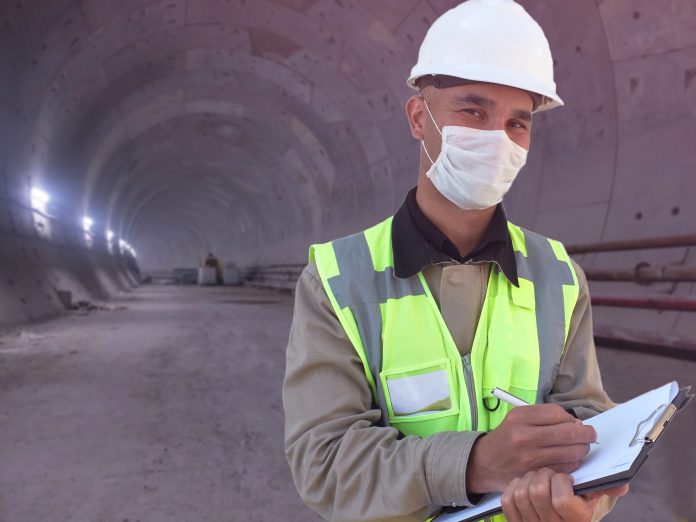As we start 2021 with the UK in lockdown 3.0 due to the ongoing Covid-19 pandemic and with the number of recorded cases now even higher than the first peak on account of the new strain of the virus, it is more important than ever that construction staff are safe at work. Gerard Stilliard of Thompsons Solicitors outlines workers’ legal rights and employers’ responsibilities to ensure their staff are safe
Many of those working in the construction industry this winter will be understandably worried about their safety. Not only are Covid-19 cases now at their highest ever but the cold, wet and dark conditions make social distancing a much greater challenge – having a lunchbreak outside isn’t the attractive option it might have been in August, for example.
There may be challenges but employers have a responsibility to ensure that, to the best of their ability, their employers are kept safe from harm, which includes from Covid-19.
If a worker has been diagnosed as having Covid-19 and there is reasonable evidence to suggest that it was caused by occupational exposure, employers are required by law to report it to the Health & Safety Executive (HSE) and their local authority.
Recent statistics from the HSE found that, between 10 April and 12 December 2020, there were 17,895 notifications of occupational Covid-19 exposure, leading to 223 deaths. Around half of these reports related to exposure between September and December 2020, when the second wave of the virus began to take hold in the UK.
The statistics show that, of every report of Covid-19 workplace exposure in construction since April, the vast majority (85%) came since September. This was largely reflective of the exposure for those working in manufacturing, at 84%.
With cases still on the rise and all sectors affected, employers cannot afford to be complacent. Their decisions could make the difference between life or death.
What are the employer’s responsibilities?
Firstly, all employers should ensure they are carrying out thorough risk assessments. This should always be the case but it’s more important now than ever.
Regulation 3 of the Management of Health & Safety at Work Regulations 1999 (MHSWR) requires every employer to make a suitable and sufficient assessment of both the risks to the health and safety of their employees while at work and the risks to those people who aren’t employed by the employer but may come into harm’s way as a result of the employer’s actions, such as a third-party contractor or visitor.
These risks must be assessed in a suitable and sufficient manner, tailored accordingly if there are staff who may be deemed as “at risk”. In the case of Covid-19, this will be particularly important if the employee has an underlying health condition, which would affect the likely severity of the condition were they to contract it. Medical evidence suggests that some groups are also at greater than average risk, such as workers aged over 70 and those from black, Asian and minority ethnic backgrounds.
Secondly, the current Covid-19 secure guidelines are an additional set of rules that employers must follow, focusing around the redesign of workspaces to maintain 2m distances between people by staggering start times, creating one-way walkthroughs, opening more entrances and exits, or changing seating layouts in break rooms.
Where a two-metre distance cannot be maintained, the employer must first ask whether that job is necessary. If it is, they should encourage employees to do everything in their power to keep themselves and colleagues safe, such as frequent and thorough handwashing, cleaning of shared surfaces, the use of screen and barriers between working areas, and reducing the number of people each employee has contact with.
For a risk assessment to have any real value, an employer needs to make sure they actually implement the preventative measures and regularly monitor their effectiveness. Employees must also be made fully aware of any issues that have arisen out of the risk assessment.
An employer has a legal duty to consult with workers and elected health and safety representatives (whether or not the union is recognised) in good time on health and safety matters including what the risks at work are, the steps taken to prevent and control those risks and how information and training will be provided.
The government’s key message has been that no one is obliged to work in an unsafe environment. But what does that mean in practice?
Anyone who has concerns about their safety should discuss them with any elected health and safety representative who can raise them with the employer. Employees have a right not to be subjected to a detriment or dismissal if they refuse to return to work because they reasonably believe that there is serious and imminent danger to health and safety.
Similar protection applies if the worker takes “appropriate steps to protect themselves”. While employees are required to draw the employer’s attention to the serious and imminent danger, this can be done by a union representative.
Whether it is reasonable for an employee to leave their workplace will depend on the extent to which the employer has assessed risk and followed government guidance, and whether the employer could introduce further safeguards, such as Personal Protective Equipment. An employer will also be expected to take into account the vulnerability of the employee or those with whom they live – for example, if they are living with or responsible for caring for a clinically vulnerable or clinically extremely vulnerable person.
What if a worker contracts Covid-19 in their workplace?
If a worker contracts Covid-19, they may be able to make a claim for damages for any harm they have suffered and any financial consequences of their illness. To do so, they would need to show that the condition is likely to have been caused by negligence on the part of their employer – for example, a failure to risk assess and implement social distancing policies meant that exposed the worker to the virus.
The solicitor would need to establish a clear timeline of events for the 10 days or so leading up to the onset of symptoms to establish how and where the exposure may have occurred, so having this information to hand is essential when launching a claim.
Covid-19 has thrown up innumerable challenges for all sectors, no less so in construction but it will only be the foolish employer that will plough ahead and make up for time lost to the pandemic without considering proper health and safety precautions. If they do, it will be their workers who suffer the consequences – and the employer will very likely to be facing litigation from those avoidably made ill.
 Gerard Stilliard
Gerard Stilliard
Head of personal injury strategy
+44 (0)330 123 1230
Twitter: Thompson Law
LinkedIn: Thompsons Solicitors
YouTube: Thompsons Law

















